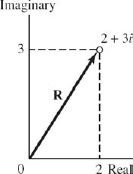19.4. Vector Operations Using Complex Numbers
An important use of a complex number is that it can represent a vector. Vectors represented by complex numbers can be easily manipulated by calculator to find rectangular components and the resultant of any number of vectors. This is our third look at vectors. It is a good time to glance back at Chapter 7 where we introduced vectors, and Chapter 8 where we manipulated vectors at any angle.
|
We did not use the TI-83/84 calculator for vectors in earlier chapters because it uses the exponential form of a complex number, which was not yet covered. We will, however, use the TI-83/84 here. |
19.4.1. Representing a Vector by a Complex Number
Figure 19-6 shows a plot of the complex number 2 + 3i. If we connect that point with a line to the origin, we can think of the complex number 2 + 3i as representing a vector R having a horizontal component of 2 units and a vertical component of 3 units.
The complex number used to represent a vector can be expressed either in rectangular, polar, or exponential form. In this section we will do all the work by calculator, for which the exponential and polar forms will be most convenient.
Figure 19.6. A vector represented by a complex number.

19.4.2. Components of a Vector
To find the rectangular components of a vector, write it in exponential form and then convert it to rectangular form. The quantities ...
Get Technical Mathematics, Sixth Edition now with the O’Reilly learning platform.
O’Reilly members experience books, live events, courses curated by job role, and more from O’Reilly and nearly 200 top publishers.

